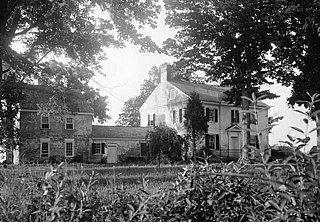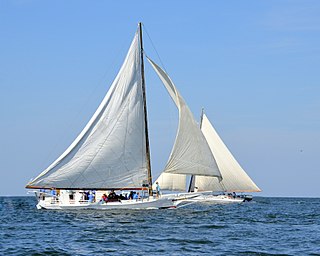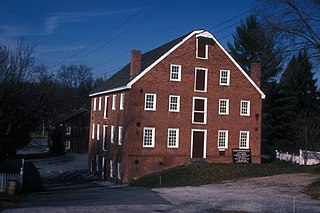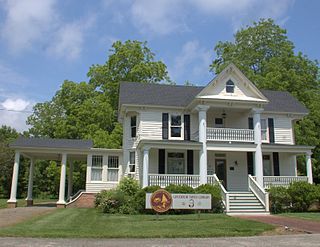
The Savage Mill Historic District is a national historic district located at Savage, Howard County, Maryland. The district comprises the industrial complex of Savage Mill and the village of workers' housing to the north of the complex.

Williston Mill Historic District is a national historic district in Denton, Caroline County, Maryland. It consists of two historic structures—a grist mill and a miller's house—which share the acreage with the mill stream and race that empties into Mill Creek, a tributary of the Choptank River. The Williston miller's house is a two-story, four-bay single-pile frame dwelling, built originally between 1840 and 1850 with later 19th century expansions. The mill building dates from around 1830–1840, with the two-story section built around 1895. It is one of two grist mills that remain standing in Caroline County.

Waterloo is a historic home located at Princess Anne, Somerset County, Maryland. It is a two-story four-room plan Flemish bond brick house, Georgian-period brick house built about 1750-1760 by Henry Waggaman. It features a Corinthian columned porch with a roof top balustrade. Also on the property is a group of outbuildings including a doctor's office, a five-car garage, a frame caretaker's house, a small pump house, and the Waggaman-Riggin family cemetery. During the 19th century the property was owned by several locally prominent families until 1864, when the farm was purchased by the county for an almshouse. The county retained ownership of the property until 1948. The house was operated as a Bed & Breakfast for several years, but is now under private ownership.
The Beauchamp House, also known as Washburn House or Long Farm, is a historic home located at Westover, Somerset County, Maryland, United States. It is a 1+1⁄2-story brick-ended hall / parlor frame house standing at the head of the Annemessex River. The main house was built in two stages, beginning with a hall-plan house, built about 1710–1730. During the second half of the 18th century, the structure was enlarged by the addition of two downstairs rooms, which were later consolidated into one.
Brentwood Farm, also known as Adams Purchase and Smith's Adventure, is a historic home located at Westover, Somerset County, Maryland, United States. It is a two-story three-bay Flemish bond brick house built about 1738. The house was enlarged by a well-designed Shingle-style / Colonial Revival addition in 1916.
Salisbury Plantation is a historic house located at Westover, Somerset County, Maryland. It has two principal sections: a 19th-century, two-story plus attic clapboard section whose roof ridge runs east to west, and a first-quarter-18th-century 1+1⁄2-story brick section with its ridge running north to south.

William T. Tull House, also known as E.D. Long House, is a historic home located at Westover, Somerset County, Maryland. It is a two-story, three-bay, center passage/double-pile plan frame dwelling, erected around 1860. Its exterior features are associated with the Greek Revival and Italianate styles.
Burton Cannon House, also known as Windsor, is a historic home located at Cokesbury, Somerset County, Maryland. It is a 1+1⁄2-story frame dwelling, four bays wide and two bays deep.. It was built in the late 1790s.

The Jeptha Hayman House, also known as Hayman Farm, is a historic home in Kingston, Somerset County, Maryland, United States. It is a two-story, five-bay weatherboard frame dwelling in the Greek Revival style. The oldest portion is dated by an inscribed brick to 1836, with an addition from about 1850. It features a Tuscan-columned porch supported on a rusticated concrete block knee wall.

Kingston Hall is a historic home located at Kingston, Somerset County, Maryland. Located along the Big Annemessex River, it is a Georgian style dwelling of two stories plus an attic, three bays wide by two deep, connected by a one-story brick hyphen to a two-story-plus-loft brick kitchen wing. Also on the property is the brick, circular ice house. The interior of the house features corner fireplaces. Interior woodwork mouldings are in a transitional style, bridging late Georgian and Federal styles.
Lankford House, also known as Anderson House, is a historic home located at Marion, Somerset County, Maryland. It is a two-story, four-bay, single-pile frame house constructed between 1834 and 1840. It features well executed, Greek Revival trim and woodwork. A single story frame hyphen connects the main house to a frame kitchen built about 1798. Also on the property is the 19th century Lankford family burial plot and frame smokehouse.

The Capt. Leonard Tawes House is a historic home located at Crisfield, Somerset County, Maryland, United States. It is a frame two story house begun in the second quarter of the 19th century and extensively altered in the Late Victorian mode through the rest of the century. Also on the property is a garage, a storage shed, a stilted frame dairy, and a gable-roofed frame privy.
Maddux House, also known as Maddux's Island, Maddux's Warehouse, Inclosure, and Capt. William T. Ford House, is a historic home located at Upper Fairmount, Somerset County, Maryland. It is located on a high ridge of land overlooking the Manokin River and Back Creek. It is a two-story, six-bay, "L"-shaped frame house with steeply pitched roofs. The house dates to the 18th century, with an addition dating to around 1850–60. It was listed on the National Register of Historic Places in 2002.
William S. Smith House, also known as Croswell House and Phoebus House, is a historic home located at Oriole, Somerset County, Maryland. It is a two-story cross-shaped frame Queen Anne house, built about 1890. It features by a pair of three-story entrance towers with pyramidal roofs marked by kicked eaves, wooden finials, and weathervanes.
The F. C. Lewis Jr. is a Chesapeake Bay skipjack, built in 1907 at Hopkins, Virginia. She is a 39-foot-long (12 m) two-sail bateau, or "V"-bottomed deadrise type of centerboard sloop. She has a beam of 14.6 feet (4.5 m) and a register depth of 3 feet (0.91 m); her register tonnage is 6. She is one of the 35 surviving traditional Chesapeake Bay skipjacks and a member of the last commercial sailing fleet in the United States. She is located at Wenona, Somerset County, Maryland.

The Fannie L. Daugherty is a Chesapeake Bay skipjack, built in 1904 at Crisfield, Maryland. She is a 41.3-foot-long (12.6 m) two-sail bateau, or "V"-bottomed deadrise type of centerboard sloop. She is built by cross-planked construction methods and has a beam of 8 feet (2.4 m) and a depth of 3.6 feet (1.1 m). She one of the 35 surviving traditional Chesapeake Bay skipjacks and a member of the last commercial sailing fleet in the United States. She is located at Wenona, Somerset County, Maryland.

The Ida May is a Chesapeake Bay skipjack, built in 1906 at Urbanna or Deep Creek, Virginia. She is a 42.2-foot-long (12.9 m) two-sail bateau, or "V"-bottomed deadrise type of centerboard sloop. She has a beam of 14.4 feet (4.4 m), a depth of 3.3 feet (1.0 m), and a net register tonnage of 7. She is one of the 35 surviving traditional Chesapeake Bay skipjacks and a member of the last commercial sailing fleet in the United States. She is located at Chance, Somerset County, Maryland.

Union Mills Homestead Historic District is a national historic district at Westminster, Carroll County, Maryland, United States.

Crisfield Historic District is a national historic district at Crisfield, Somerset County, Maryland, United States. It consists of a cohesive collection of houses, churches, and commercial buildings dating primarily from about 1870 to 1930. They reflect the rapid growth of the town as the center of the booming Chesapeake Bay oyster industry during that period. The district encompasses much of Crisfield's main residential and commercial areas, locally known as "uptown." The Crisfield Armory is located within the district boundaries.

Lehman's Mill Historic District is a national historic district at Hagerstown, Washington County, Maryland, United States. The district comprises the remaining buildings of the mill group including the brick Lehman's Mill, built in 1869 for Henry F. Lehman, the farmstead with a stuccoed stone house dated 1837 with older and newer sections, a barn, carriage house, and agricultural outbuildings; another dwelling, also built by Lehman in 1877, a two-story brick and frame house; related outbuildings, and a portion of the mill's head and tail race. It is the oldest continuously operating mill in Washington County, and is the most intact mill complex remaining in the county.
















